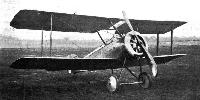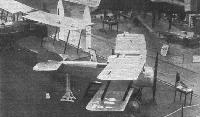
Варианты
- Sopwith - Pup - 1916 - Великобритания
- Beardmore - W.B.III - 1917 - Великобритания
- Sopwith - Dove - 1919 - Великобритания
Sopwith Pup
<...>
В 1919 году была предпринята попытка использовать высокие летные характеристики Pup в коммерческих целях - был создан двухместный гражданский вариант Dove. Но установленный на нем ротативный ПД Le Rhone плохо подходил для эксплуатации частными пилотами, и производство ограничили всего 10 самолетами, большинство из которых продали за рубеж.
Описание:
- Sopwith Pup
- Flight, December 1919
SOME POST-WAR SOPWITH MACHINES - Flight, July 1920
The Olympia Aero Show 1920
Фотографии
-
Aeroplane Monthly 1991-07 / M.Oakey - Grapevine
Регистрационный номер: G-EAGA [7] Exquisite Sopwith Dove reproduction G-EAGA, newly completed for Roger Reeves by Skysport Engineering at their base near Sandy in Bedfordshire. The first flight was imminent as this issue went to press.
-
Aeroplane Monthly 1991-07 / M.Oakey - Grapevine
Регистрационный номер: G-EAGA [7] -
Aeroplane Monthly 1993-06 / M.Oakey - Grapevine
Регистрационный номер: G-EAGA [7] Roger Reeves’s Skysport-built Sopwith Dove G-EAGA airborne at Old Warden on April 10, 1993 - the first two-up dual-control rotary-engined flight in the UK for many years. Bonedomed duo Pete Kynsey (front) and Stuart Goldspink (rear) did the honours.
-
Aeroplane Monthly 1993-10
Регистрационный номер: G-EAGA [7] First air-to-air of Roger Reeves's Sopwith Done replica, built by Skysport Engineering and first flown on March 28 this year. Taken by MIKE VINES / PHOTO LINK on a sortie from Old Warden on August 20, it shows G-EAGA being flown by Stuart Goldspink.
-
Aeroplane Monthly 1993-09 / M.Oakey - Grapevine
Регистрационный номер: G-EAGA [7] A remarkable Sopwith line-up at the Sundown Flying Display at Old Warden on the evening of July 17, 1993. From left to right: AJD’s newly-completed Sopwith Camel G-ASOP/B6291 (which made its first post-rebuild flight on July 27); Sopwith Triplane "N6290"; Sopwith Pup N5180 and Sopwith Dove G-EAGA.
Другие самолёты на фотографии: Sopwith Camel / F.1 - Великобритания - 1916Sopwith Pup - Великобритания - 1916Sopwith Triplane - Великобритания - 1916
-
Мировая Авиация 239
После войны на базе Pup был создан двухместный Dove. Построили только десять самолетов, большую часть из которых продали за рубеж.
-
Aeroplane Monthly 1979-10 / D.Brown - Wings over Sussex (2)
Регистрационный номер: G-EBKY [2] The Sopwith Dove evolved from the Pup fighter.
-
Flight 1919-12 / Flight
The Sopwith "Dove" sporting two-seater, 80 h.p. Le Rhone
-
Flight 1920-07 / Flight
The Sopwith "Dove" sporting two-seater
-
Flight 1920-07 / Flight
The Sopwith Dove is a development of the famous Sopwith "Pup."
-
Aeroplane Monthly 1990-07 / M.Oakey - Grapevine
Регистрационный номер: G-EAGA [7] Sopwith Dove reproduction G-EAGA is taking shape at Skysport Engineering near Sandy, Bedfordshire. Being built to original Sopwith drawings for collector Roger Reeves, the Dove will befitted with dual controls - one of only three airworthy World War One-era aircraft in Europe to be thus equipped (Shuttleworth’s Avro 504K and a Morane Parasol in France are the others).
-
Aeroplane Monthly 1991-03 / M.Oakey - Grapevine
Регистрационный номер: G-EAGA [7] This superb pholograph by IAN FRIMSTON depict the latest progress with Roger Reeves’s Sopwith Dove reproduction G-EAGA, nearing completion in the hands of Bedfordshire-based Skysport Engineering. They were taken at Skysport's Rotary Farm base - note the company’s “plane" logo on the hangar.
-
Aeroplane Monthly 1981-11 / Sopwith Dove G-EBKY /Preservation Profile/
Регистрационный номер: G-EBKY [2]
- Фотографии














